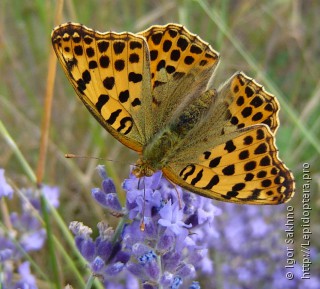Issoria lathonia
Taxonomy
class Insecta
Species name(s)
Issoria (Issoria) lathonia (Linnaeus, 1758) = Papilio lathonia Linnaeus, 1758 = Papilio valdensis Esper, [1804] = saturata (Röber, 1896) = hungarica (Aigner-Abafi, 1906) = florens Verity, 1916 = sheljuzhkoi (Stauder, 1923) = Argynnis interligata Cabeau, 1919 = Argynnis neopina Wize, 1930. [9, 10, 187]
Queen of Spain Fritillary.
urn:lsid:insecta.pro:taxonomy:8579
Expansion
This species marks on the maps: 6.
Zoogeographical regions
Palaearctic.
Russia regions
#1. Kaliningradsky; #3. Karelsky; #4. Evropeisky Severo-Zapadny; #6. Evropeisky Severo-Vostochny; #7. Evropeisky yuzhno-tayozhny; #8. Evropeisky Tsentralny; #9. Evropeisky Tsentralno-Chernozyomny; #10. Sredne-Volzhsky; #11. Volgo-Donsky; #12. Nizhnevolzhsky; #13. Zapadno-Kavkazsky; #14. Vostochno-Kavkazsky; #15. Severo-Uralsky; #16. Sredne-Uralsky; #17. Yuzhno-Uralsky; #19. Sredneobsky; #20. Yuzhno-Zapadnosibirsky; #22. Krasnoyarsky; #23. Predaltaisky; #24. Gorno-Altaisky; #25. Tuvinsky.
Forewing length
20—22 mm.
Primary colors
Orange, Green, Brown/Gray/Black, White.
Flight time
| January | February | March | April | May | June | July | August | September | October | November | December |
Larva lifespan
| January | February | March | April | May | June | July | August | September | October | November | December |
Detailed information with references
Distribution
Imago Habitus and Differences from alike species
General info about Imago
Imago lifespan
General info about Larva
Larva food plants / other food objects
Larva lifespan
Pupa
Egg
Overwintering stage
Subspecies of Issoria lathonia
- Issoria lathonia attenuata de Sagarra, 1926. [187]
- I. l. clara Agenjo, 1948. [187]
- I. l. costimaculata Lempke, 1956. [187]
- I. l. emiflorens Verity, 1919. [187]
- I. l. florens Verity, 1916. [187]
- I. l. garciai Agenjo, 1948. [187]
- I. l. isaea (Gray, 1846). [9]
- I. l. isaeoides Reuss, 1925. [9]
- I. l. laufferi Agenjo, 1948. [187]
- I. l. magisnigrata Verity, 1933. [187]
- I. l. maximemaculosa Verity, 1933. [187]
- I. l. messoa Fruhstorfer, 1912. [187]
- I. l. messora (Fruhstorfer, 1909). [9]
- I. l. nigriorattenuata Verity, 1933. [187]
- I. l. nigroprivata Verity, 1933. [187]
- I. l. nigropuncta Verity, 1933. [187]
- I. l. postlathonia Verity, 1933. [187]
- I. l. pseudosaturata Agenjo, 1948. [187]
- I. l. saturata Röber, 1896. [187]
- I. l. secunda Obraztsov, 1934. [187]
- I. l. sheljuzhkoi Stauder, 1923. [187]
- I. l. transversa Lempke, 1956. [187]
- I. l. vareai Agenjo, 1948. [187]
- I. l. vilarrubiai Agenjo, 1948. [187]
- I. l. vivesi Agenjo, 1948. [187]
Authors
Initial species uploading to the site: Peter Khramov.
Text data: Peter Khramov.
The species characteristics formalization: Peter Khramov.
References
- [1] O. Karsholt, J. Razowski (eds.), 1996. The Lepidoptera of Europe: a distributional checklist
- [3] Каталог чешуекрылых (Lepidoptera) России. Под ред. С. Ю. Синёва. СПб.; М.: Товарищество научных изданий КМК, 2008
- [9] Tree of Life (funet.fi), 2012
- [10] de Jong, Y.S.D.M. (ed.) (2011) Fauna Europaea version 2.4 (faunaeur.org)
- [28] Moths and Butterflies of Europe and North Africa (leps.it), 2012
- [85] Lepidoptera species catalogue, Lepidoptera.ru, 2015
- [187] Species 2000, http://www.sp2000.org
Comments
Note: you should have a Insecta.pro account to upload new topics and comments. Please, create an account or log in to add comments
Issoria lathonia photos























































All the photos of the species in large size
Please, create an account or log in to upload your photo



